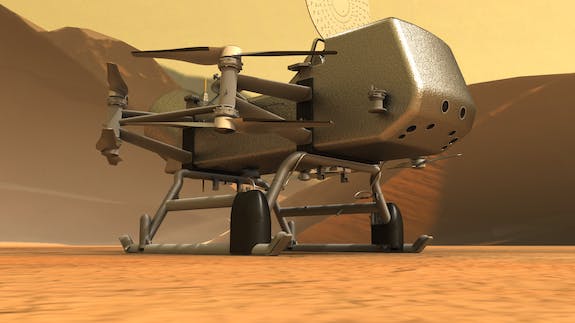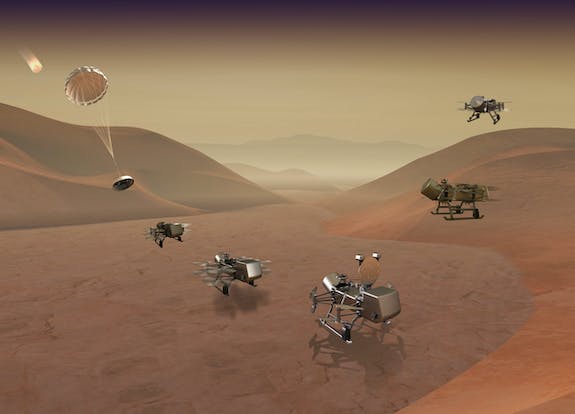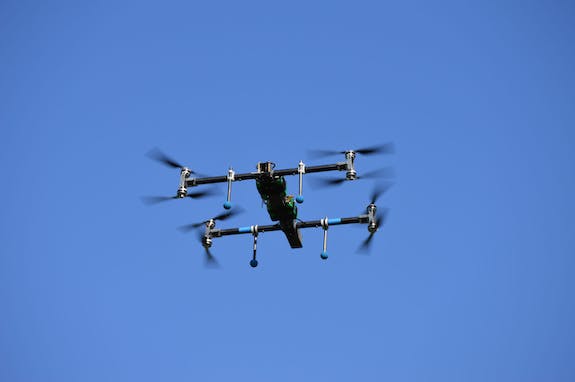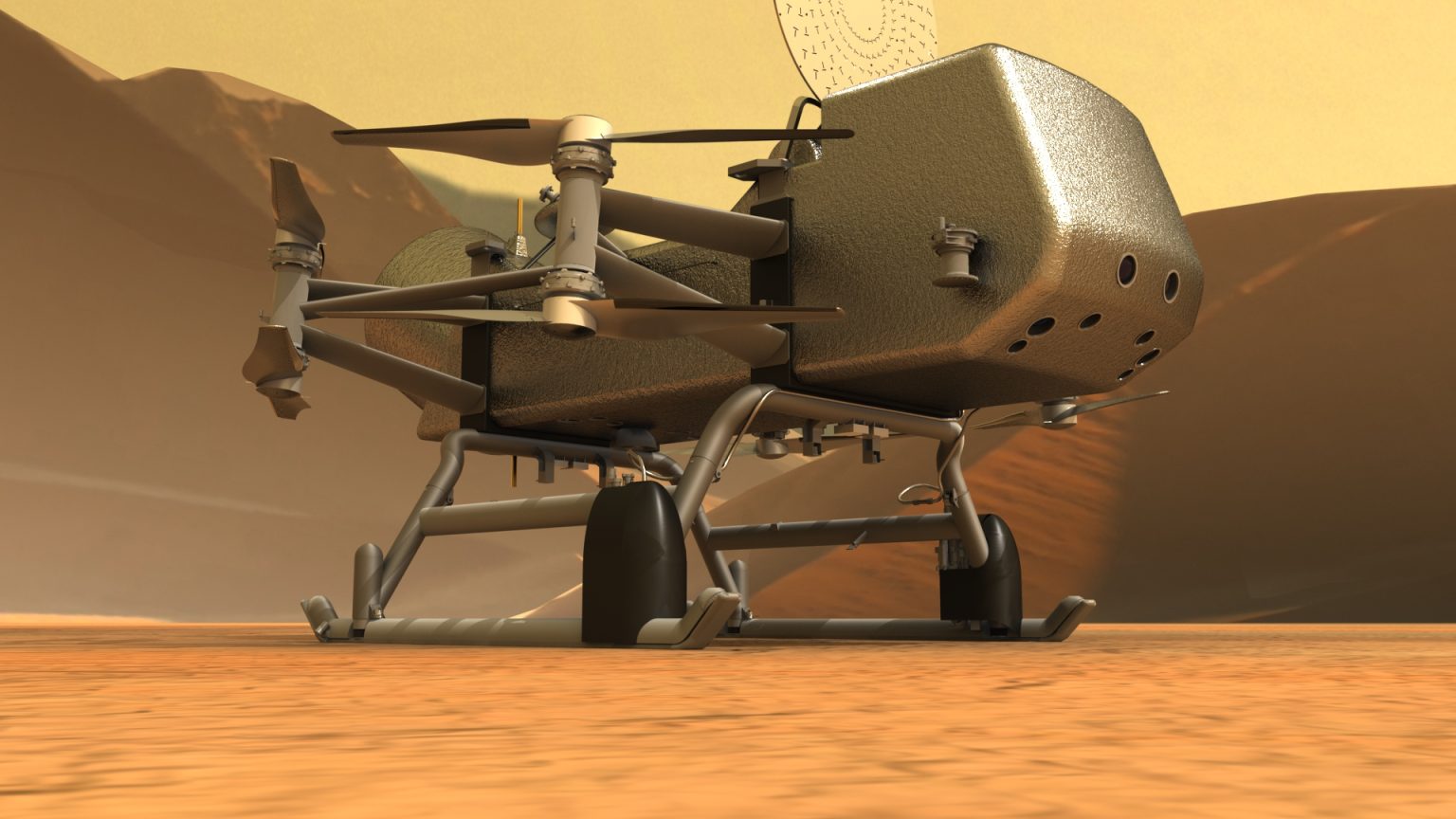During the 13 years Cassini studied Saturn, the spacecraft captured 453,048 images, discovered six new moons and completed 294 orbits, all before making its fiery final descent into the planet’s atmosphere on Sept. 17, 2017.
Cassini also made dozens of flybys of Saturn’s largest moon, Titan. Given its rocky core and thick atmosphere, scientists suspected that Titan might have striking similarities to Earth.
Cassini confirmed those suspicions when, using its onboard radar, the spacecraft penetrated Titan’s thick nitrogen-methane atmosphere to find lakes, seas and rivers of liquid methane and ethane as well as mountains, hills, dunes and drainage channels.
On Jan. 14, 2005, Cassini launched the Huygens probe, which parachuted down to Titan’s surface, giving humanity its first good glimpse of the moon’s terrain. Huygens and Cassini added volumes to what we know about Titan, including that the moon contains water and complex organic molecules—the basic ingredients of life—in abundance.

In summer of 2019, NASA announced another mission to the surface of Titan: Dragonfly, which is scheduled for launch in 2028. Like Cassini, the Dragonfly spacecraft would use a radioisotope power system (RPS) provided by experts at U.S. Department of Energy national laboratories. Idaho’s national lab and its land-grant university are both contributing to the mission.
“We have on Titan the opportunity to observe the processes that were present on early Earth when life began to form,” Lori Glaze, director of NASA’s planetary science division, said on this video about the mission. “And possibly even conditions that may be able to harbor life today.”
Unlike the Mars rovers that drive around on the Red Planet’s surface, Dragonfly is a drone similar in size to a small car. Using eight rotors, Dragonfly will fly over Titan’s alien landscape from location to location, akin to how a helicopter flies on Earth. In between those flights, Dragonfly will take scientific measurements with instruments designed to detect the precursors of life.

To power Dragonfly, NASA plans to use a Multi-Mission Radioisotope Thermoelectric Generator (MMRTG), the same power source used by the Curiosity rover on Mars. The MMRTG would be fueled and tested at Idaho National Laboratory.
MMRTGs turn the heat from the radioactive decay of plutonium-238 directly into electricity. NASA has relied on radioisotope power systems to power its spacecraft and rovers for more than 50 years. INL recently finished fueling the power source for the Mars 2020 Rover and will focus on Dragonfly’s MMRTG next. Experts from Oak Ridge National Laboratory and Los Alamos National Laboratory make and process fuel, and fabricate and test components for the MMRTGs.
Although the specific electrical power output of the Dragonfly MMRTG depends upon a number of factors, the power source would not provide enough power on its own to enable flight from sample location to sample location, said Jason Barnes a professor of physics at the University of Idaho and Dragonfly deputy principal investigator.
Last November, Barnes gave a talk about Dragonfly in Idaho Falls at the Center for Advanced Energy Studies, a research and education consortium among Idaho National Laboratory, Boise State University, Idaho State University, the University of Idaho and the University of Wyoming.
Instead of relying on the MMRTG alone, electricity from the MMRTG would accumulate in a rechargeable lithium-ion battery until it’s time for another flight. “The MMRTG would produce about 100 watts,” Barnes said. “And, it takes kilowatts to fly. It’s like an electric car. We ‘plug it in’ and it charges overnight.”

On Titan, “overnight” is a lot longer than on Earth. “We have eight Earth days when we can’t see it or talk to it,” he said. “We charge it overnight and work from that battery in the day. It takes a while to get the charge it needs.”
Stephen Johnson, director of INL’s Space Nuclear Power and Isotope Technologies Division, said, “The team from the three national labs will work closely with project leaders and power systems experts at the Johns Hopkins Applied Physics Laboratory, which manages Dragonfly and will build and operate the drone for NASA, as well as engineers from Aerojet Rocketdyne, a private company based in California that makes the MMRTG itself.”
Dragonfly is designed to move to different sample locations and measure the surface composition, particularly the organics (materials made of carbon). Taking lessons learned from the Mars rovers, Barnes and the team thought a drone might be a better option for Titan, especially given Titan’s reduced gravity, seven times lower than Earth’s, and dense atmosphere, four times denser than Earth’s.
“This is the easiest place to fly in the entire solar system,” Barnes said. “We were trying to figure out how to get between the dunes and the interdunes. On Mars, we do this on wheeled rovers, but on Titan, we can actually fly.”
And, since the mission already called for a flight system to relocate to different science regions, Dragonfly’s designers decided to use this same flight system to safely make the first landing.
Dragonfly will land near Selk crater, an impact scar that was produced by a five-mile-wide object that slammed into Titan’s surface traveling at tens of miles per second.
That collision likely generated enough heat to create a melt pool in the 56-mile-wide crater that may have lasted 10,000 years or more. During that time, Titan’s abundant organic molecules may have interacted with liquid water.
Scientists believe that liquid water, carbon and carbon compounds, and a source of energy are necessary in order to sustain life. Except for Earth, scientists suspect that Titan has the most organic-rich surface material in the solar system.
To test those compounds, Dragonfly will use a drill and vacuum. Inside Dragonfly, scientific instruments, including a gas chromatograph mass spectrometer, will analyze the samples, especially amino acids, and send the data back to Earth.
Throughout the mission, the MMRTG would not only supply power, but also heat. Titan’s average surface temperature is about minus 290 degrees Fahrenheit. The solution is a thermal loop that takes heat from the MMRTG and distributes it within the lander, including to the science instruments, and warms them up to about 32 F.
“MMRTGs aren’t efficient for electrical power, but they generate heat really well,” Barnes said. “It’s an absolutely essential piece of equipment.”







